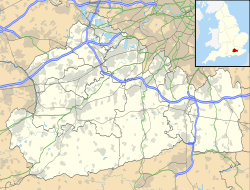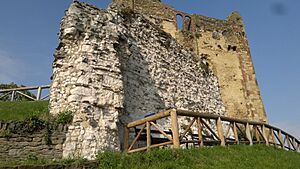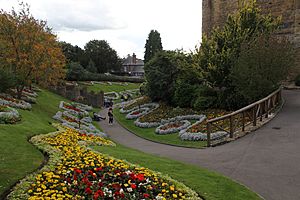Guildford Castle facts for kids
Quick facts for kids Guildford Castle |
|
|---|---|
| Surrey, England | |
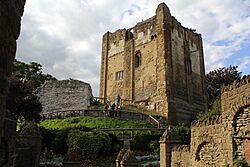
The keep of Guildford Castle
|
|
| Coordinates | 51°14′04″N 0°34′21″W / 51.234314°N 0.572431°W |
| Grid reference | SU 99768 49312 |
| Type | Motte and bailey |
| Site information | |
| Owner | Guildford Borough Council |
| Open to the public |
Yes |
| Condition | Ruined |
| Site history | |
| Materials | Bargate stone |
| Events | |
| Official name | Guildford Castle |
| Designated | 1 January 1920 |
| Reference no. | 1012340 |
|
Listed Building – Grade I
|
|
| Official name | Castle Keep, Guildford |
| Designated | 1 May 1953 |
| Reference no. | 1377881 |
Guildford Castle is an old castle located in Guildford, Surrey, England. Many people believe it was built by William the Conqueror himself, or one of his important knights, soon after the Normans invaded England in 1066.
Contents
The Castle's Story
Early Days: 1000s to 1200s
How the Castle Was Built
After the Battle of Hastings in 1066, William the Conqueror led his army through England. He passed through Guildford, and it's thought the castle was started after this time. The Domesday Book of 1086, which listed everything in England, doesn't mention the castle. This means it was probably built after 1086.
The first part of the castle was likely a motte, which is a large earth mound. Around this mound was a ditch and a bailey, or courtyard. A wooden fence called a palisade protected the bailey. The bailey's edge would have been where Castle Street and Quarry Street are today. It might have been split into two parts, an outer and an inner bailey. On top of the motte, a wooden tower, or keep, would have stood as a lookout.
Later, in the late 1000s or early 1100s, a stone wall was built around the top of the motte. This created a "shell keep." Around the 1130s, a tall stone tower, also called a keep, was added. This tower was made from strong Bargate stone found nearby. Its walls were very thick, about 10 feet (3 meters) at the bottom.
The stone keep had a ground floor and a first floor. The entrance was on the first floor for better defense. The King likely used the first floor as his private rooms. It had a main room, a small chapel, and a toilet area. A second floor was added later, making the keep over 70 feet (21 meters) tall. The roof was made of lead, and the inside walls were painted white.
In the 1100s, the King moved to nicer rooms in the bailey. These main buildings included a great hall and separate apartments for the King and Queen. King Henry III made many improvements in the 1200s, making the castle feel more like a palace. The Queen's rooms got new windows and marble columns. The great hall was decorated with colorful glass and paintings. King Henry even had his own room painted green with gold and silver stars. He also built a garden with marble columns.
In 1245, Henry bought more land to make the bailey bigger. This allowed him to build new rooms for his son, Edward, who would later become King. These rooms were finished in 1246. A new gate was built in 1256, showing that Henry kept making changes to the castle.
The Castle as a Fortress
The castle was mostly a royal home, but it was also a strong fortress. Even though it was never attacked, its defenses were made stronger many times.
The keep was likely made taller during the civil war in King Stephen's time (1135–1154). It was also strengthened when King Henry II's sons rebelled in 1173–1174.
On July 9, 1216, Prince Louis of France took control of the castle during a war against King John. However, there was no fighting at the castle itself.
During the rebellion led by Simon de Montfort in the 1260s, Guildford Castle saw no battles. But King Henry III's son, Prince Edward (who became King Edward I), captured a rebel leader named Adam Gurdon nearby. He brought Gurdon to Guildford Castle. The castle was also used as a meeting point for soldiers during King Edward I's wars abroad.
Castle Keepers and Sheriffs
Important people called constables and sheriffs were in charge of Guildford Castle. In 1218, William de Coniers was the constable. Later, in 1259, William de Aguillon, who was the sheriff of Surrey, was given charge of the castle. It was probably used as a prison then.
In 1307, Edward de Say, who looked after the King's prisoners, was told to fix the prison. In 1367, Andrew Sackville, the sheriff for Surrey and Sussex, was given the castle to use as both a prison and a home. In 1377, Sir Simon Burleigh, who had taught King Richard II, became the constable.
Later Years: 1300s to 1900s
Over time, Guildford Castle, like other royal castles away from the coast, was not needed for defense as much. It became less important and was not looked after well. From the 1360s, a royal hunting lodge on the other side of the river was improved. Kings and queens preferred to stay there instead of the castle.
The royal rooms at the castle fell apart. By 1379, only the King's main room was left. The rest of the royal apartments were too damaged to fix.
The castle keep continued to be used as a prison for both Surrey and Sussex until 1487. At that time, people from Sussex asked for prisoners to be moved to Lewes, which had a safer prison. Their request was granted.
In 1544, John Daborne became the keeper of the castle garden. His family looked after the castle for the rest of the 1500s. They are thought to have added brick windows and fireplaces to the tower. In 1611, King James I gave the castle land to Francis Carter. In the 1630s, after the tower's roof was removed, it was used for cockfighting. Parts of the castle grounds were also used for farming.
Around 1820, the Duke of Norfolk bought the castle. In 1885, Lord Grantley, who owned a large part of the castle, sold it to the Guildford Corporation (the local council). The tower and walls were fixed up and opened to the public as beautiful gardens in 1888. This was to celebrate Queen Victoria's Golden Jubilee from the year before.
Guildford Castle Today
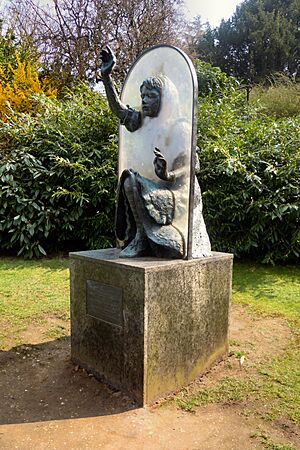
Today, the castle gardens are very popular. They have many colorful flowers and plants, all around the 12th-century Castle Keep. There is also a life-size statue of Alice Through the Looking Glass. This statue is a memorial to Lewis Carroll, the author, who lived nearby from 1868 until he passed away in 1898.
From 2003 to 2004, a big project took place to protect and fix the castle. The keep was partly renovated, and the first floor was given a new floor and roof. During this work, original features like the castle's battlements (the notched walls at the top) were found.
The keep now has a visitor center, which is open from April to September. Inside, you can find information panels that tell the castle's history. There's also a model showing what the castle looked like around the year 1300. You can climb a staircase to the roof of the tower for great views of the gardens and parts of Guildford.
The castle's old gatehouse is now part of Guildford Museum. This museum shares local history and archaeology. It also has a special collection of needlework.


